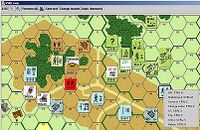Software:Wargame (video games)
Wargames are a subgenre of strategy video games that emphasize strategic or tactical warfare on a map, as well as historical (or near-historical) accuracy.[1]
History
The genre of wargame video games is derived from earlier forms of wargames. The games thematically represent the wargame hobby, although they tend to be less realistic in order to increase accessibility for more casual players. The amount of realism varies between games as game designers balance an accurate simulation with playability.
The wargaming community saw the possibilities of computer gaming early and made attempts to break into the market, notably Avalon Hill's Microcomputer Games line, which began in 1980 and covered a variety of topics, including adaptations of some of their wargames.
In February 1980 Strategic Simulations, Inc. (SSI) was the first to sell a serious, professionally packaged computer wargame, Computer Bismarck, a turn-based game based on the last battle of the battleship Bismarck.[2][3] It and Strategic Studies Group (SSG) were computer game companies that continued the genre by specializing in games that borrowed from board and miniature wargames. The companies enjoyed a certain popularity throughout much of the 1980s and into the 1990s. TalonSoft started in 1995 with a similar focus, until purchased and later closed down by Take-Two Interactive in 2002.
Game design
The primary gameplay mode in a wargame is usually tactical: fighting battles. Wargames sometimes have a strategic mode where players may plan their battle or choose an area to conquer, but players typically spend much less time in this mode and more time actually fighting. Because it is difficult to provide an intelligent way to delegate tasks to a subordinate, war games typically keep the number of units down to hundreds rather than hundreds of thousands.[4]
Units are usually scaled to be disproportionately large compared to the landscape, in order to promote effective gameplay. These games usually use a much faster time line than reality, and thus wargames often do not model night time or sleep periods, though some games apply them, they can be time-consuming.[4]
Comparison with traditional wargames
Many contemporary computer strategy games can be considered wargames, in the sense that they are a simulation of warfare on some level. The mechanics and language have little in common with board and miniature games, but the general subject matter is popular and provides a thematic link.
Tabletop wargames are usually categorized according to the scale of the confrontation (e.g., grand strategy wargame, strategic wargame, operational wargame, tactical wargame or man-to-man wargame). The qualifiers "real-time" and "turn-based" are not taken into account as all tabletop wargames are, by necessity, turn-based. However, sometimes video wargames are also described according to the scale of conflict.
While it has been argued that computer wargame video games lack the realism of traditional games, they may include features that are impractical for tangible games. One such approach is using fog of war, whereby players are unable to see the landscape beyond the simulating viewing distance of their units. This is made practical in digital games by the fundamental difference of competing against artificial intelligence or remote competitors with their own view of the playing field.
Notable computer wargames
- Computer Bismarck - (Strategic Simulations, 1980) - generally credited as the first "serious" computer war-game.
- Eastern Front (1941) - (Atari Program Exchange, 1981) - Called "the first war game that competed with pencil-and-paper games" and one of the best selling programs on the Atari 8-bit family. Introduced scrolling maps, pondering AI, morale, supply considerations and many other advanced features that were common in later games. Chris Crawford's first major success.
- Panzer General - (Strategic Simulations, 1994) - recognizably a traditional wargame next to Close Combat. It spawned several sequels, some of which explored different subject matter.
- Steel Panthers - (Strategic Simulations, 1995) - a tactical wargame on the same scale as Squad Leader, which led to two sequels, and then a series of titles by Camo Workshop/Shrapnel Games and Matrix Games, for free release.
- Close Combat - (Microsoft, 1996) - not the first wargame to break out from hexes, and still presented in a 2-dimensional format, Close Combat addressed factors such as individual morale and reluctance to carry out orders. The original title led to five successful sequels for the general public, as well as being developed into a training tool for military use only. Close Combat stemmed from an early attempt to translate the Squad Leader boardgame to the computer.
- Combat Mission - (Big Time Software, 2000)
See also
- Chronology of grand strategy video games
- List of video games
References
- ↑ Walker, Mark H. (February 2002). "Strategy Gaming: Part III -- Strategy Gaming". GameSpy. http://archive.gamespy.com/articles/february02/strategygames3/index2.shtm. Retrieved 2009-06-28.
- ↑ Proctor, Bob (March 1988). "Titans of the Computer Gaming World / SSI". Computer Gaming World: pp. 36.
- ↑ "This is why we play war games". Plarium. https://plarium.com/en/mmo-games/we-play-war-games/. Retrieved 2018-03-29.
- ↑ 4.0 4.1 Rollings, Andrew; Ernest Adams (2006). Fundamentals of Game Design. Prentice Hall. http://wps.prenhall.com/bp_gamedev_1/54/14053/3597646.cw/index.html.


